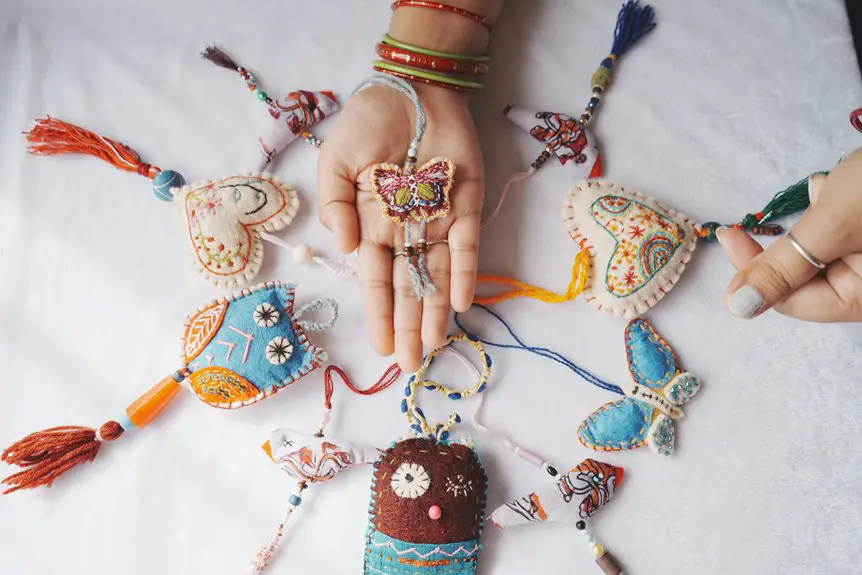Ramie fabric offers you a durable, breathable option with a silky feel that rivals cotton and linen. It’s eco-friendly, using less water and pesticides, and it resists wear well. However, you might find it stiff at first, prone to wrinkles, and less sun-resistant. Care requires gentler washing and ironing. Overall, it’s a stylish choice if you value strength and comfort, but there are trade-offs worth considering before deciding if it’s right for you. Exploring further reveals more details.
Table of Contents
Key Takeaways
- Ramie fabric offers a luxurious silky texture, superior durability, and breathability, making it ideal for stylish, long-lasting clothing.
- It is eco-friendly, requiring less water and pesticides, and grows rapidly with multiple annual harvests.
- Ramie resists wear, maintains strength when wet, and withstands frequent washing without pilling or sagging.
- Care requires gentle washing, avoiding bleach, and ironing to manage stiffness and wrinkles.
- Cons include initial stiffness, proneness to wrinkling, potential shrinking, and limited availability affecting cost and choice.
What Is Ramie Fabric?
Ramie fabric comes from a natural fiber that’s derived from the stalks of the ramie plant, a flowering plant native to East Asia.
Ramie fabric is made from the natural fibers of the ramie plant, native to East Asia.
When you touch ramie fabric, you’ll notice its silky luster and smooth texture, making it feel quite luxurious. It’s one of the oldest fibers used for textiles, prized for its strength—actually, it’s stronger than cotton—so your clothes or linens will hold up well over time.
Ramie is often blended with other fibers like cotton or wool to improve durability and softness. You’ll find it in various products, from clothing to home textiles.
Just remember, since ramie doesn’t stretch much, garments made from it might feel a bit stiff until they soften with washing and wear.
Environmental Impact of Ramie Production
You’ll want to contemplate how sustainable ramie farming is before choosing this fabric.
While ramie plants grow quickly and need less water, the processing often involves chemicals that can harm the environment.
Understanding both the farming and chemical use helps you make a greener choice.
Sustainability of Ramie Farming
Because sustainable farming practices matter more than ever, understanding the environmental impact of ramie production is essential.
When you choose ramie fabric, you support a crop that often requires less water and fewer pesticides compared to conventional cotton.
However, sustainability depends on how the ramie is farmed. Here’s what you should consider:
- Ramie plants grow quickly and yield multiple harvests annually
- They thrive in poor soils, reducing the need for synthetic fertilizers
- Ramie cultivation helps prevent soil erosion due to its dense root system
- Crop rotation with ramie can improve soil health and biodiversity
- Sustainable practices like organic farming further minimize ecological footprints
Chemical Usage in Processing
Although the farming of ramie often emphasizes sustainability, the chemical treatments used during its processing can still pose environmental challenges.
When you buy ramie fabric, you mightn’t realize that to soften the fibers and remove natural gums, manufacturers often use strong chemicals like sodium hydroxide and bleaching agents. These substances can pollute water sources if not properly managed, harming local ecosystems.
Additionally, chemical runoff may affect soil quality, reducing long-term land fertility.
However, some producers are adopting eco-friendlier methods, such as enzymatic treatments, to reduce chemical use.
As a conscious consumer, you should look for certifications or brands that prioritize green processing techniques to minimize your environmental impact while enjoying ramie’s natural benefits.
Durability and Strength of Ramie Fabric
When you choose ramie fabric, you’re opting for a material known for its impressive durability and strength. Ramie fibers are naturally robust, making the fabric resistant to wear and tear.
This strength means your clothes or home textiles will last longer, even with frequent use. Here’s what you should know about ramie’s durability:
- Ramie is stronger than cotton and retains strength when wet.
- It resists stretching and sagging over time.
- Its stiffness adds to structural integrity but can reduce flexibility.
- The fabric holds up well to frequent washing without significant damage.
- Ramie is less prone to pilling compared to other natural fibers.
Moisture Absorption and Breathability
When you wear ramie fabric, you’ll notice it absorbs moisture differently than cotton or linen.
Its breathability makes it a great choice for warm weather, keeping you cool and comfortable.
Let’s explore how its moisture absorption and airflow compare to other fabrics.
Absorption Rate Comparison
Since moisture management plays a key role in fabric comfort, understanding how ramie compares in absorption and breathability is essential.
Ramie excels in absorbing moisture quickly but doesn’t retain it like cotton does, which means you feel less damp during wear. Compared to other natural fibers, ramie’s absorption rate sits between linen and cotton, offering a balanced performance.
Here’s what you should know:
- Ramie absorbs moisture faster than synthetic fabrics.
- It releases moisture quickly, reducing dampness.
- Cotton holds more moisture but dries slower.
- Linen’s absorption is similar but often feels rougher.
- Ramie’s absorption aids in keeping you comfortable during moderate activity.
Knowing these points helps you decide if ramie suits your moisture-wicking needs.
Breathability in Warm Weather
Although ramie shares some moisture absorption traits with other natural fibers, its breathability truly shines in warm weather.
When you wear ramie, you’ll notice how it allows air to flow freely, keeping you cool and comfortable even on hot days. Its natural structure promotes ventilation, which helps wick away sweat and moisture from your skin quickly.
Unlike some synthetic fabrics that trap heat, ramie lets your body breathe, reducing the chances of overheating or feeling sticky. This makes it an excellent choice for summer clothing or humid climates.
If you want fabric that balances moisture management with airflow, ramie offers a practical solution. You’ll appreciate how it keeps you fresh without sacrificing durability or style during warm weather activities.
Comfort and Feel Against the Skin
Because ramie fabric is naturally breathable and smooth, you’ll often find it comfortable to wear, especially in warm weather. It feels lightweight and airy, which helps prevent overheating and sweat buildup.
Ramie fabric is naturally breathable and lightweight, making it ideal for staying cool and comfortable in warm weather.
However, ramie can sometimes feel a bit stiff initially, but it softens with washing and wear.
When you slip into ramie clothing, you’ll notice:
- A crisp texture that adds structure to your outfit
- A cool touch that feels invigorating on your skin
- Minimal irritation, making it suitable for sensitive skin
- A slightly rough feel when new, improving over time
- Enhanced moisture-wicking properties for dryness
Care and Maintenance Requirements
Caring for ramie fabric requires a bit more attention than typical cotton or polyester.
You’ll want to wash ramie in cold water using a gentle cycle to prevent shrinkage and preserve its strength. Avoid bleach or harsh detergents, as they can weaken the fibers.
When drying, opt for air drying or tumble dry on low heat to reduce wrinkles and maintain the fabric’s integrity.
Iron on a medium setting while the fabric is slightly damp to smooth out creases effectively.
Since ramie can be prone to stiffness, you might consider using a fabric softener occasionally.
Common Uses of Ramie in Fashion and Home Textiles
Ramie’s durability and natural luster make it a popular choice in both fashion and home textiles. When you choose ramie, you get a fabric that looks elegant and stands up to wear.
Ramie combines elegance and strength, making it a favored fabric for stylish, long-lasting fashion and home textiles.
You’ll find it used in:
- Lightweight summer clothing like blouses and dresses
- Blended fabrics to add strength and sheen
- Upholstery fabrics for a polished, natural look
- Table linens and curtains that resist wrinkles
- Decorative pillows offering a subtle texture
Because ramie resists stretching and mildew, it’s ideal for items that need to stay crisp and fresh.
Whether you want breathable, stylish clothes or sturdy home textiles, ramie fits the bill. Its versatility lets you enjoy both comfort and durability without sacrificing style.
Cost Comparison With Other Natural Fabrics
While natural fabrics each come with their own price points, you’ll find that ramie often falls in the mid to upper range compared to cotton, linen, and hemp. Its durability and luster contribute to a higher cost than cotton but usually less than premium linen or hemp. When deciding, consider not just price but also fabric performance and longevity.
| Fabric | Average Cost per Yard (USD) | Durability Rating (1-5) |
|---|---|---|
| Cotton | $5 – $10 | 3 |
| Ramie | $8 – $15 | 4 |
| Linen | $12 – $20 | 4 |
| Hemp | $10 – $18 | 5 |
This comparison helps you weigh value against cost effectively.
Potential Drawbacks and Limitations of Ramie Fabric
Even though ramie offers several benefits, you should be aware of some drawbacks before choosing it.
Ramie fabric isn’t without its limitations, which might affect its suitability for your needs. For instance, you might find it less elastic compared to other fibers, making it prone to wrinkling. Plus, it can be stiff unless blended with other materials.
Here are some potential drawbacks to evaluate:
- Prone to wrinkling, requiring frequent ironing
- Stiff texture if used 100% pure
- Less durable when exposed to sunlight for long periods
- Can shrink if not cared for properly
- Limited availability may affect cost and choice
Keep these factors in mind to decide if ramie fabric fits your lifestyle and preferences.
Frequently Asked Questions
Can Ramie Fabric Be Blended With Synthetic Fibers?
Yes, you can blend ramie fabric with synthetic fibers to enhance durability and flexibility. This combination improves wrinkle resistance and strength, making your garments more versatile while maintaining ramie’s natural breathability and texture.
Is Ramie Fabric Hypoallergenic?
You’ll find ramie fabric is naturally hypoallergenic, making it great for sensitive skin. It resists bacteria and mildew, so you won’t have to worry about irritation or allergic reactions when you wear or use it.
How Does Ramie Fabric React to Dyes?
You might be surprised—ramie fabric absorbs dyes exceptionally well, producing vibrant, long-lasting colors. However, its natural stiffness means you’ll need special care during dyeing to avoid uneven shades or damage to the fibers.
Are There Any Cultural Significances of Ramie Fabric?
You’ll find ramie fabric holds cultural significance in countries like China and Japan, where it symbolizes purity and longevity. It’s traditionally used in ceremonial garments, connecting you to rich heritage and craftsmanship with every wear.
Can Ramie Fabric Be Used for Outdoor Clothing?
You can use ramie fabric for outdoor clothing, but it’s not the best choice. It’s breathable and durable, yet it wrinkles easily and isn’t very water-resistant, so you’ll want to treat it for moisture protection.
- Comparing All Major Resist Dyeing Techniques - July 13, 2025
- Batik Technique: Using Wax and Dye to Create Art - July 13, 2025
- How to Successfully Dye a Disc Golf Disc at Home - July 13, 2025







